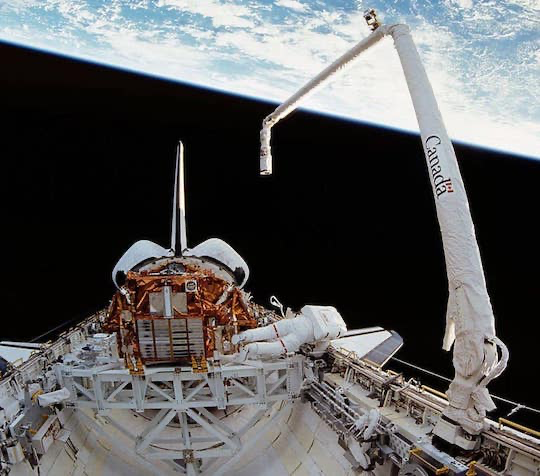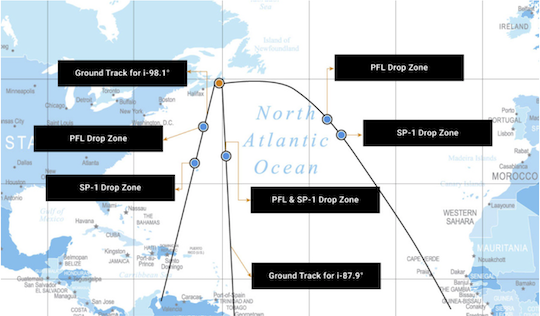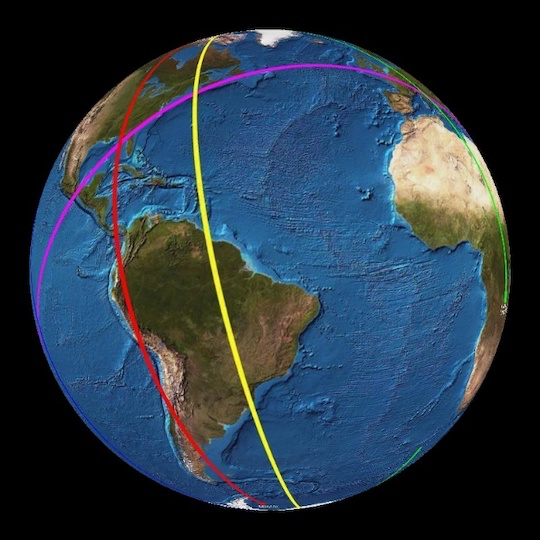
Posted May 29, 2024
By Byron King
King: Canada’s Cape Canaveral North
Recently, the government of Canada made a major decision: it wants a space launch site in-country and will spend serious funds to get one.
In fact, the government of Canada just announced a multimillion-dollar deal to backstop construction of a new spaceport, essentially Canada’s version of Cape Canaveral. There are many angles to this; whether you are an investor or not, you might want to know more. So read on…
 Canadian astronaut Chris Hadfield. Courtesy NASA.
Canadian astronaut Chris Hadfield. Courtesy NASA.
Access to Space
In 2024, putting satellites into space is a half-trillion-dollar global business. It’s big money and getting bigger.
Take all the world’s space programs, military and civilian: U.S., Russia, China, Europe, India, Israel, Japan, South and North Korea, and numerous others, including private companies like United Launch Alliance (Boeing-Lockheed), SpaceX, Blue Origin and, again, many more. Add up the spending, and it’s in the $500 billion range: a big number growing fast and heading towards a trillion-dollar-plus by 2035.
It's no stretch to say that every advanced industrial country has a space program or wants one. Access to space is crucial to being a respected world power.
Along these lines, Canada has significant aerospace history and impressive capabilities. These range from superb universities and world-class rocket scientists to a wide variety of companies that provide space-rated metals and materials, rocket and satellite design, electronics, software, and much else. At the government level, much of Canada’s space effort is coordinated by the Canadian Space Agency (CSA), Canada’s equivalent of NASA.
Canada can build both rockets and payloads. It has astronauts who have flown in space; the above-pictured Chris Hadfield comes to mind, along with numerous other spacefarers. Over the past 75 years, Canada has contributed to innumerable space missions that launched into earth orbit, efforts in planetary geology on earth and elsewhere in the solar system, and, of course, astronomy.
 “Canadarm” robotic maneuvering device, used on over 90 space shuttle missions. Courtesy NASA.
“Canadarm” robotic maneuvering device, used on over 90 space shuttle missions. Courtesy NASA.
Canada’s Missing Launch Site
However, something is distinctly missing from Canada’s space achievements and future goals: a launch site. Canada has no venue from which to launch rockets into space. But that’s about to change.
It may seem odd that Canada can’t launch its own rockets. After all, Canada is a big place—the second largest country in the world by area after Russia—and much of that is sparsely populated territory. Canada also borders three oceans.
What gives? There ought to be a way for Canada to launch rockets into space, right? There ought to be a way to deliver and deploy satellites from Canadian territory, right? So why is there no launch site in Canada? First, let’s do something that’s always useful and look at a map.
 Canada is a big place. But there are not a lot of potential launch sites.
Canada is a big place. But there are not a lot of potential launch sites.
With a glance, Canada’s rocket problem is evident. That is, launches obviously involve firing rockets up into the sky and “downrange,” meaning that the rocket and payload fly aloft at some inclination to the earth’s equator to achieve orbit. Without getting too deep into details, the exact orbit depends on what the satellite is intended to do and what areas it serves.
In other words, if you fire a rocket from most parts of Canada, either Canadian or U.S. land lies beneath the trajectory. That kind of event involves risk to people, human structures, or natural features on the ground along the track.
For example, what happens when a booster separates and falls or if something worse happens (if you know what I mean)? If you’re in the rocket business, you don’t want to launch and drop anything on someone’s head, wreck property, cause fires, etc.
So, despite its vast land area, most of Canada is unsuitable for rocket launches into space. And, oh, by the way, sounding rockets for, say, weather or upper atmospheric research are another story. Canada has those, but they don’t go into orbit, and we’re not addressing that matter here.
Let’s be clear. If someone in Canada fires a rocket from just about anywhere in the country towards the south, debris could fall on Canadians or people in the U.S. If the rocket launches to the north, debris might fall on Russia, on the other side of the North Pole. That’s unacceptable, too, of course.
From the standpoint of basic geography, what’s the best place in Canada to site a rocket launch facility?
Look at that map again. The best place to launch from Canada is near the southeast coast, along the Atlantic Ocean, from the Maritime Provinces. In particular, the area with the most existing infrastructure, such as roads, rail, access to ports, power lines, industry, and people in Nova Scotia. So, how about a site not far from the maritime city of Halifax?
 Notional launch tracks out of Nova Scotia, with a much empty ocean beneath.
Notional launch tracks out of Nova Scotia, with a much empty ocean beneath.
Launched from Nova Scotia, a rocket will track across little else but the ocean to the east and southeast and deep saltwater directly to the south.
 The open, blue-water ocean south and southeast of the Maritimes. Courtesy NOAA.
The open, blue-water ocean south and southeast of the Maritimes. Courtesy NOAA.
North America’s Launch Sites
Let’s consider a few basics for rocket launches from North America (note: other big space players like Russia and China have their own different geographic circumstances).
First, the proximity to the Atlantic Ocean is exactly why the U.S. long ago constructed two of its key launch sites along the East Coast, at Cape Canaveral, Florida, and Wallops Island, Virginia. Both are NASA sites with significant military associations, and both locales are heavily booked for launches.
The launch process from Canaveral or Wallops is well-developed. Rockets fly up, and expended items drop into the sea. Since we’re talking about rocket science, this simplifies the overall process, which includes near-endless checklists for safety and effective operations.
Meanwhile, another critical U.S. rocket base is at Vandenburg, California, northwest of Santa Barbara. All launches from that site head south or southwest over the vast Pacific Ocean, and they are essentially all dedicated to military missions such as putting spy satellites into polar orbits or testing intercontinental missiles.
This immediately leads to another issue for the fast-growing space launch industry. Namely, government launch sites are tightly tied up with military and other government tasks. In this sense, they’re booked by large government contractors for space missions via companies like United Launch Alliance (Boeing-Lockheed) and SpaceX. Good luck if you’re a small operator or a corporate or university research customer with an experiment to launch. Take a number and wait.
Meanwhile, the U.S. military has recently surged into a massive test program for hypersonic weapons, an understandable reaction to what we’ve seen with Russia in Ukraine. This effort has tied up many military and other government facilities and ranges with new, ongoing, likely long-term commitments. Plus, these kinds of weapon tests require highly restrictive security protocols.
On the civilian side, SpaceX works at a feverish pace to launch its high volume of satellites from existing facilities. Mr. Musk’s company lights off as many as two rocket flights per week from Cape Canaveral. All in all, it’s tough for anyone else to find an open slot.
In addition, the complication is that rocket launch sites tend to be associated with military airspace and test ranges, which, on the best days, are tightly controlled in terms of access and use. Just obtaining clearances to move people into position, plus equipment, and sharing all manner of range tracking, safety, and communication systems creates hurdles.
The good news for Canada is that the country enjoys a long-term, close working relationship with the U.S. for military and civilian space cooperation. There’s a vast network of Canada-U.S. channels for joint efforts. [Full disclosure: long ago, when I was in the U.S. Navy, I worked routinely and closely with Canada’s Department of National Defense, and many of our mutual issues involved aerospace and space cooperation.]
Still, it’s fair to say that over many decades, Canada has played second fiddle regarding access to space via U.S. sites. American needs always came first; Canadian military and civilian organizations had to request launch and range access from the U.S. government for anything they wanted to put into orbit.
Well (and it’s a long story, not here), Canada has determined to create its own launch capability to gain additional options for both military and civilian access to space.
Canada’s New Launch Site: the Maritimes
Enter onto the stage a small company with strong upside, Maritime Launch Services, Inc. (OTC: MAXQF), headquartered in Halifax. Right now, the market cap is small, about $30 million (U.S.); the OTC share price is in the $0.07 range, and shares are thinly traded. Ownership is concentrated in the hands of management, a couple of high-risk, early-stage investment funds, and a small group of bold retail buyers.
In this sense, Maritime Launch is, by definition, one of those proverbial Canadian “penny stocks.” And no, we are not formally recommending this company as an investment for subscribers. But it’s worth discussing and keeping an eye on because, for all the risk, Maritime Launch is uniquely positioned to capitalize on the new Canadian effort to establish its own national gateway to space.
One item that helps seal the deal is the company’s recent agreement with both Nova Scotia province and federal Canada governments, out of Ottawa, to extend generous terms to reimburse the costs for various launch facilities. In other words, government agencies are putting real cash on the table to pay for concrete and steel, so to speak, to make things happen.
Another point to explain is the Maritime Launch business case, which is what’s called an “airport model” to generate revenue. That is, government agencies or private customers will make short-, medium-, or long-term leases on facilities at the site, such as land and buildings in which to conduct final assembly and checkout of systems. Clients and customers will also pay for using the launch pads, range equipment, and services like airspace clearance, fuel handling, communications, tracking, safety support, and more.
Maritime Launch is discussing with many potential customers, but details must be publicly available. We know that one test launch is scheduled this summer to prove the capability to loft a rocket and support all the ground and range systems. This is a necessary milestone to attracting more customers, and on that point, we’ll wait and see.
In general, launching rockets is all about location-location-location. The Maritime Launch location is a lonely stretch of uninhabited, former public lands in Nova Scotia at Canso, now leased long-term. The bedrock geology is post-glacial granite, with a thin surface cover of soil and scrub vegetation and minimal water table.
In other words, the locale offers no significant environmental or development challenges, unlike, say, Cape Canaveral where most of the acreage is protected wetlands. (Yes, NASA must work with the EPA and U.S. Fish and Wildlife Service to do as much as roll a backhoe off of any established road.)
As for local residents, a recent survey revealed that about 88% of the public support in Nova Scotia was for building the Canso site into a spaceport for Canada. As you can imagine, politicians love it.
The Canso site is just off the Trans-Canada highway, with ample power adjacent via high-capacity electric lines. The front gate is less than two miles from a railhead, and the site is under a mile from ocean access.
To move people and equipment there, the region boasts an international airport at Halifax. The runway measures 10,500 feet long, which is more than enough to accommodate the largest and heaviest cargo aircraft.
In the sky above, Halifax and the Nova Scotia coastline are about 50 miles south of all major transatlantic airline routes. Hence, launching rockets won’t disrupt any heavily trafficked North America-Europe air corridors. And airspace to the south, out over the Atlantic, tends not to be too busy most of the time, facilitating restricting flights during launch windows.
The Halifax region is served by the Port of Halifax, one of Canada’s major container ports. The loading-unloading facilities are just down the waterfront from a major Canadian naval base and a major shipyard, Irving Shipbuilding. Irving Shipbuilding is a sophisticated company that has designed and constructed over 80% of the vessels in Canada’s navy.
Thus, when it comes to launching rockets, Canso has easy access to road, rail, air, ship, and container cargo. Transporting rockets and payloads to the site is no major logistical challenge. Plus, the Halifax region has ample facilities to provide and store common rocket fuels, including high-purity kerosene, liquid oxygen, and various other flight-related substances.
Of course, launching rockets requires skilled workers. Halifax is a city of nearly half a million, with another 350,000 people in the Nova Scotia region. The province has a full range of schools, up to the level of research universities, of which Dalhousie stands out. It also hosts a significant presence in Canadian defense and civilian scientific establishments.
In other words, Halifax offers ample potential for the necessary industrial, engineering, and scientific skills to build and maintain a spaceport. Plus, as time passes, outside companies that establish a presence for long-term work to launch rockets and payloads will bring in their workers from other locales.
One last point to consider is the legality of shipping high-tech rocket and satellite equipment outside the U.S., a matter covered by numerous laws and regulations. The good news is that the governments of the U.S. and Canada have reached a tech-transfer agreement that will permit U.S. companies to move space equipment and related tech across the border.
There’s plenty more to say, but that’s all for now. To sum up, Maritime Launch is a small company with grand ambitions, a unique location and business case, and strong government support to accomplish its goals.
(Please note: We are not recommending this company in our portfolio but believe it to be a future investment idea worth considering.)
I’ll continue to follow this story. Be assured, I’m watching developments… In fact, I’m planning to go to Halifax this summer for that test launch.
Thank you for subscribing and reading.

Oil Off The Boil
Posted December 24, 2025
By Sean Ring

Gold Bars, Up Bars, and FUBAR
Posted December 23, 2025
By Sean Ring

EX-SQUEEZE ME!
Posted December 22, 2025
By Sean Ring

Swamp, Brains, and the Game
Posted December 19, 2025
By Sean Ring

WTI…WTF?
Posted December 18, 2025
By Sean Ring
